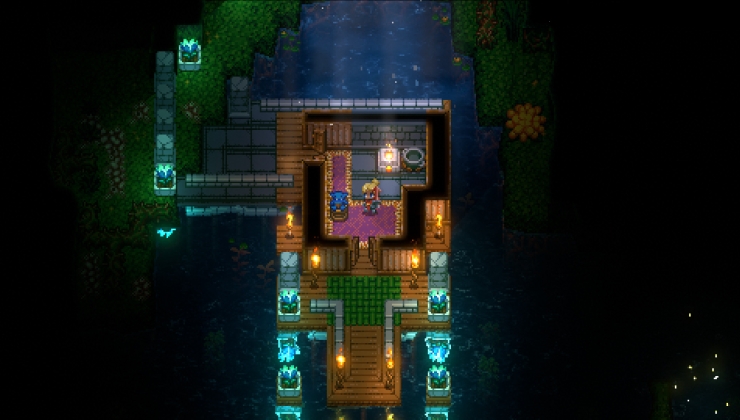At the end of every year, our team sets aside time to review and assess the past twelve months and recalibrate our priorities for the future.
This annual exercise gives us an opportunity to explain exactly what we spent our time on and why. It also lets us lay out a bunch of data and decisions in front of the broader PC industry, which we believe generate a useful feedback loop of questions, suggestions, and requests from game developers and publishers. Encouraged by those results, we’ve kept up the practice each year-- and now we have this 2021 Year In Review ready to share with you.
Steam’s ongoing success is ultimately driven by two factors: the games available to players, and the quality of experience players can have with those games. In general, we direct our energy towards two goals:
- Make sure PC games can quickly and easily ship on Steam, minimizing friction and maximizing developer control.
- Provide games with a rich, ever-improving ecosystem of tools and features so that Steam is the best place for customers to own and play the game.
The majority of this post expands on all the work we did in 2021 to serve those objectives.
You can also check out our
2020,
2019, and
2018 editions of the Steam Year In Review.
Steam platform growth
2021 was successful even in comparison to 2020’s unprecedented growth. Players spent almost 38 billion hours on Steam in 2021 - a 21% increase over 2020. (That's a whopping 4.3 million years of playtime.)
Player spending on games rose 27% compared to 2020, growing even more than playtime did. That growth wasn't just due to existing players, either - Steam saw 2.6M first-time purchasers each month of 2021, roughly the same rate of new purchaser growth we saw in 2020 as the global pandemic unfolded.
The platform also saw amazing growth in digital gift cards. This feature was first introduced back in 2017, but usage shot up this year so we wanted to share an update.
Steam Digital Gift Cards are a useful way for customers to gift Steam wallet credit to friends and family regardless of currency or country. None of the transaction costs are passed on to purchasers or game publishers, and the end user can seamlessly use their Steam Wallet funds for every single game, DLC or microtransaction across the platform with zero friction. More than 2.6 million digital gift cards were sent in 2021, and the dollar value of those gift cards increased 43% compared to 2020.
It’s also worth pointing out that 2021 saw the addition of some beloved formerly-console-exclusive games from our friends at
Sony and
Microsoft. There are no bad years to be a PC gamer, but 2021 was an especially good one. From Days Gone to Forza Horizon 5, players on PC got to enjoy an incredible lineup from some of the best first-party console studios on the planet. That explosion of fresh content is a testament to the open, competitive nature of the PC ecosystem, where players have the broadest choice of what hardware to play on, what stores and services to use, and which games to play.
And while we didn’t release any new VR games ourselves this year, the VR ecosystem continues to thrive on Steam. Years ago, we made it a priority for SteamVR to be open and accessible, and worked to support as much hardware as we possibly could (even if it was made by our competitors in the space). That strategy continues to reward end users and game developers. New VR users grew another 11% in 2021, with unique play sessions up 22%. And the newest major hardware release, the Oculus Quest 2, makes up more than a third of VR headsets on Steam. Best of all,
SteamVR on Windows now fully supports the OpenXR 1.0 API, allowing developers to build their application once and run it natively across all major PC VR hardware. SteamVR gets regular updates, which you can follow
here if you’re building VR products.
Steamworks updates
At the heart of Steam is the set of tools, features and APIs that you know as Steamworks. Every year, we add quality-of-life improvements to core functions, and ship new tools and features to expand what’s possible on Steam—and developers get instant access to all of that for free, just by putting their game on Steam. A primary goal for our team is to introduce tools and features that can make your game better for players, without dictating which features you use, or gating them behind paywalls or additional agreements. Here are some of the highlights from 2021.
The Steamworks SDK got a major update.
In September, we rolled out
Steamworks SDKv1.52. Much of this update relates to Steam Deck, so we’ll talk more about it below. The other highlights were a slew of Steam Input improvements, a few quality of life improvements for Workshop/UGC, and a big refresh of our Steamworks Example Project.
Patch notes got a lot of love.
Customers would often see an update to an installed game and wonder, “what changed?” So
we built a new flow to make it easier to post patch notes when you update your build, and added a Patch Notes display to the Downloads page in the Steam client.
Steam Playtest unlocked new opportunities for free open beta testing.
After five months in beta,
April marked the full release of Steam Playtest—allowing any developer to set up and run free beta testing directly from a game’s store page in Steam. We built this with developer autonomy in mind: you control when to open and close the playtests; how many players to include; and even which countries to run the test in (for example, if there's a need to load-test regional servers). Any game with a public presence in the Steam store can use Playtest without fees or friction, no matter how big your playtest gets or where you game is in its development lifecycle.
Controller usage stats were added to the Sales data pages.
There are 48 million controllers registered by Steam users, and they're being used in over 10% of daily game sessions. As of February,
developers on Steam can now see detailed breakdowns of that controller usage—and you can follow that link to learn more about controller usage on Steam in general. Players on PC are free to plug in whatever hardware or peripherals they want, and we’re always amazed at the variety of flight sticks, racing pedals, and dance pads we see in the controller usage data.
SteamPipe got, um, bigger pipes.
SteamPipe is the system developers use to upload and distribute their builds, and thanks to an improvement back in February,
the ceiling on build upload speeds has been raised significantly, providing faster upload times for every developer.
Remote Play brought online support to local-only multiplayer games.
Back in 2019, we launched a feature called
Steam Remote Play, which let customers access and play games from their PC while on the couch, or on the go. Remote Play is provided to every game on Steam and requires no custom integration. In March of 2021, that feature got even better with new Remote Play Together features, so
customers can instantly share a local multiplayer session over Valve’s network, with no cost to the player or game developer. One player owns and runs the game, and their friends can quickly join in, even if the game developer never built online multiplayer support. Amazingly, this tool even works for friends who don’t have a Steam account— all they need is a smartphone, tablet, or PC. Since launching the new
Together
features last spring, shared gameplay has made up 34% of all remote play sessions.
Steam marketing and community updates
Layered on top of all those technical tools, features, and infrastructure is the Steam storefront-- a product that impacts thousands of studios and millions of players. We try to approach work on the storefront from two angles simultaneously: giving developers better tools and data to run their businesses, and giving customers a better experience to find and play games. 2021 saw some great additions to both sides of that coin.
Steam Next Fest has created a seasonal focal point for upcoming games and demos.
With a few clicks of a mouse, developers can sign their game up for a Steam Next Fest event, where millions of players try out demos and watch livestreams.
These events have generated a bunch of benefits for participating games, but they’re also an entertaining way for customers to survey the landscape of upcoming titles. We introduced a new flow to automatically notify developers about upcoming Next Fest events if they have an eligible game, and started hosting informational Q&A chats so game devs could sync up with the Next Fest team for advice and help.
Collaborative Bundles made it fast and simple to team up for cross promotions.
When Complete-the-Set bundles were first introduced on Steam, they gave customers a better way to “upgrade” to an entire season pass, franchise, or collection. That proved so popular that a bunch of developers reached out, asking Valve to make bespoke cross-promotional bundles including titles from multiple studios. To make sure every game on Steam had access to that opportunity, we built
Collaborative Bundles, allowing multiple studios to team up in a single bundle, and update it (or remove it) on the fly.
Seasonal sale events attracted new customers and delighted existing players.
Minigames, narrative arcs, chat stickers, awards voting—Steam’s annual sale events are something special. 2021’s Summer Sale was the biggest event in Steam’s history, with revenue for game developers growing 13% over Summer Sale 2020. But that record only stood for a few months, because the 2021 Winter Sale was even bigger. And Winter Sale 2021 also welcomed first-time purchasers to the platform: 2.3 million people all bought a game on Steam for the first time in the same 14-day window.
Events from external organizers brought new perspectives and unique lineups to the store.
In addition to some of the big Valve-managed sales, we also had the pleasure of working with partners and featuring games from around the world. That included
Black Voices in Gaming,
The Indian Harvest Festival,
LudoNarraCon,
Tokyo Game Show, and many more. We wrote more in-depth about these (and others) in our
Year-To-Date recap here.
Adding UTM analytics made it possible for game publishers to track the value of their off-Steam marketing.
This one involved some long, careful thought to ensure that customer privacy was protected and game developers were given helpful insights. While Steam itself remains an ad-free platform—we don’t sell marketing placement, search ads, or anything else—game publishers use a variety of paid advertising and unpaid marketing to help build their audience and connect with customers. Being able to evaluate those marketing efforts is extremely valuable, and publishers were quick to start using UTM analytics on Steam—in 2021, there were over 400 million visits to more than 44,000 titles via external links with UTM parameters. That’s why
we added anonymized UTM traffic analytics to Steam this year. No personal data or SteamIDs are ever included, but publishers can more easily measure how many wishlists or purchases some external source provided them.
Developer outreach and Steamwork Virtual Conference helped our team connect with devs around the globe.
Travel and event restrictions have disrupted everything from coffee meetups to tradeshows, so we’ve shifted a lot of that energy online. In 2021, folks from the Steam business and dev teams have joined roundtables and online conferences across the globe—roundtables with first-time Swedish game developers, the BIG (Brazil’s Independent Games Festival), Africacomicade, and more. These events are a two-way street for us, where we share the latest info and guidance about Steam while responding to feedback, questions and concerns from game devs. We expanded those efforts even further with our own
Steamworks Virtual Conference on community and communication, with talks and Q&As from Valve and other studios, and participants from 74 different countries. (There was also a Virtual Conference about Steam Deck, but more on that below!)
Customers got a bunch of new ways to browse the Steam catalog.
April saw
a major upgrade to category and genre discovery on Steam, which better takes into account the questions a player might ask themselves when searching for content—what gameplay mechanics are there, what themes or settings are involved, who can I play the game with? This makes it a lot easier for customers to find the right game, but it also surfaces a lot of useful data to the industry at large—for instance, you can gather data and insights before release by checking out the top-selling casual tower defense games, or analyzing the new & trending turn-based JRPGs, or whatever categories and genres make sense for your game.
Steam Deck
Valve now has a decade of experience designing hardware, including
the very first Steam Controller and the best-in-class
Index VR kit. Just a few days ago, we launched our latest hardware project,
Steam Deck: a powerful, portable gaming PC built around Steam games and features. The broader Steam team at Valve spent a ton of time and energy on it in 2021, so we wanted to include it in our Year In Review. Lots more Deck news will be coming in the weeks ahead, but here are some of the big takeaways from 2021.
Steam Deck combines ease and simplicity with openness and flexibility.
Because Steam Deck is a linux PC, users can install their own software, plug in peripherals, or even install a different operating system. But the baseline SteamOS experience boots directly to the Steam library, enabling a frictionless experience to download and play your library of games.
A new “Deck-Ready” section of Steamworks makes it easy for developers to prepare for Steam Deck.
We’ve already sent out hundreds of free
Developer kits to studios, but the number of partners on Steam far exceeds our dev kit capacity, which made it necessary for us to roll out
a new segment of Steamworks dedicated to getting ready for Steam Deck. We know that especially for older, already-released games, developers will have limited resources to make a game run on a new platform, so we’re putting a bunch of resources into our SteamOS and
Proton tools so that most Windows builds can generally run smoothly without work or updates from developers.
Major technical investments with Anti-Cheat providers are solving problems for online multiplayer games.
The work on this began in early 2021, and collaboration with Easy Anti-Cheat and BattlEye is yielding big rewards for players and game makers. Adding Steam Deck support to existing EAC games is now
a simple process, and doesn't require updating game binaries, SDK versions, or integration of other account systems. Alongside our
BattlEye updates from November, this means that the two largest anti-cheat services are now easily supported on Proton and Steam Deck.
The Steam SDK was updated to support new Steam Deck use cases.
In September,
the latest SDK rolled out improvements across the board, with a particular focus on Steam Deck. ISteamUtils added calls to support checking if a game is running on the hardware, presenting the on-screen keyboard, and gracefully handling Suspend/Resume states. And the updates to ISteamRemoteStorage supported our new
Dynamic Cloud Sync, allowing games to provide a better cloud save experience when a player moves from Steam Deck to desktop.
Virtual Conference delivered data and best practices to help studios get the most out of Steam Deck and Proton.
As we mentioned above, Steamworks Virtual Conferences were a new pandemic-proof method for us to share information and gather feedback. In November, we hosted a Virtual Conference all about Steam Deck. Those of you who joined for the livestream may recall some, ah, technical difficulties with the broadcast… thanks for being patient and sticking with us! And of course,
all of the talks are available for free here. Best of all, the suggestions and questions we got during the conference informed a
new FAQ to get developers up to speed.
We're very excited to see Steam Deck out in the wild, and we believe it will meaningfully expand the benefits of PC gaming for the whole industry. Looking ahead, we plan to launch Steam Deck availability in more territories, and continue to ship software and firmware updates to improve the user experience for Deck. In the meantime, follow us
@OnDeck to see gameplay videos and other updates.
But wait, there’s more…
There are a few ongoing efforts we want to highlight because we think they’re especially useful to the PC community at large, even if they aren't strictly specific to 2021.
The first is our monthly “Top 20” charts and blog posts, where
we shout out the best-performing new releases on the platform every month and share some insights about those games (and the studios who made them). Studios from 35 different countries were represented, ranging from Costa Rica to Estonia to Thailand. And there were lots of newcomers, too-- more than a third of our top releases in 2021 were from developers shipping on Steam for the first time. This monthly list of games is a useful pulse on what customers are enjoying, and it also showcases the diversity of games and developers finding success on Steam. A particularly good example of that is Chinese developers, who have seen a 300% growth in sales from non-Chinese markets in the past year alone and have a frequent presence in those Top 20 posts. We love seeing studios leverage Steam to gain success both at home and abroad, and as mentioned above, we periodically support sales and events that spread regional and cultural awareness. Some recent examples are Melbourne International Games Week, the Games From Quebec Sale, and the globally popular Lunar New Year sale that has become one of the four annual Steam-wide sale events.
In addition to those monthly Top 20 updates, we also share a treasure trove of data about our platform on a weekly and monthly basis. Between the
Steam Hardware Survey and the
Steam Download Stats, game developers can get an instant snapshot of the Steam user base to inform all manner of product decisions. Developers can see the average download speeds for customers in Brazil, or view the breakdown of language preference among customers, or even check the distribution of GPUs across the playerbase.
Another area where we invest a lot of time and energy is infrastructure. We run our own huge network of servers to deliver content across the globe, and we partner with ISPs to make sure download speeds for Steam are fast and accessible. A major priority in 2021 was optimization and efficiency, and we began an upgrade process to reduce our physical footprint and power usage thanks to increased CPU capacity and capability. For instance, upgrades to our servers in Los Angeles cut power usage there by 50%, even while delivering more and faster downloads to customers.
We already upgraded a quarter of those global server locations, with an aggressive timeline to get at least half of them done by the end of 2022. Those expansion efforts make a big difference because of Steam’s continued growth—as the graph below demonstrates, we delivered nearly 33 exabytes of content to customers in 2021, a 30% increase on top of the already substantial growth of 2020. It’s pretty hard to grasp a number that big, but just for fun: 33 exabytes is about how much data you’d use if the 330 million people in the United States all downloaded a 100GB game. With more customers and larger game downloads, a robust and efficient network is essential—and as always, there are no fees or charges associated with game install size, bandwidth usage, or game updates.
Before we wrap up, it's worth acknowledging just how many tools, features, and solutions on Steam have sprung out of feedback and requests from game devs. Major expansions to the platform that now seem obvious, like
Steam Workshop or
Steam Events, have their roots in conversations with studios and publishers who were asking for better ways to connect with their players. If you're working on your next Steam release right now and there's a problem you think we should solve at a platform level,
please let us know. (You can also use that path if you just have a technical question or need advice!)
And if any of the problems we deal with sound interesting to you, we'd love to talk to you--after all,
we're always hiring.










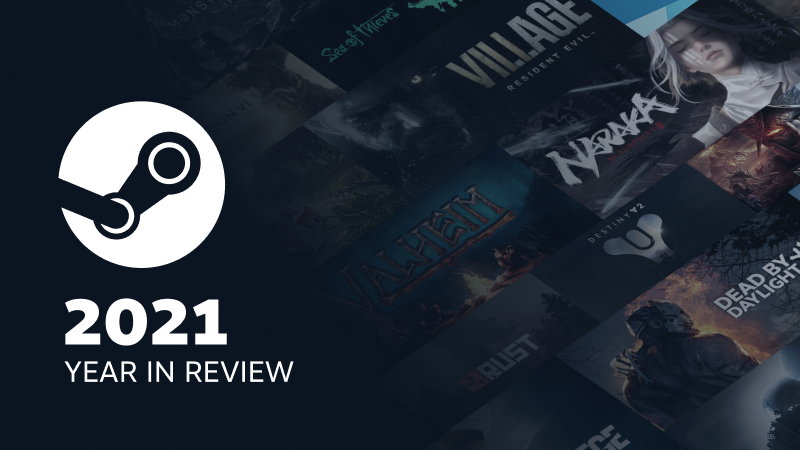

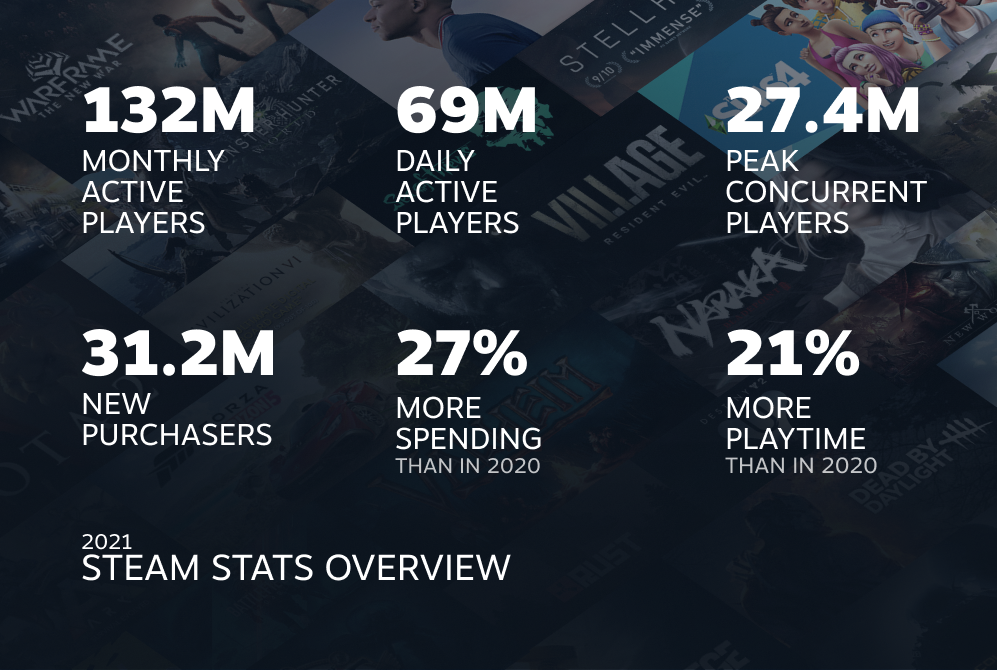

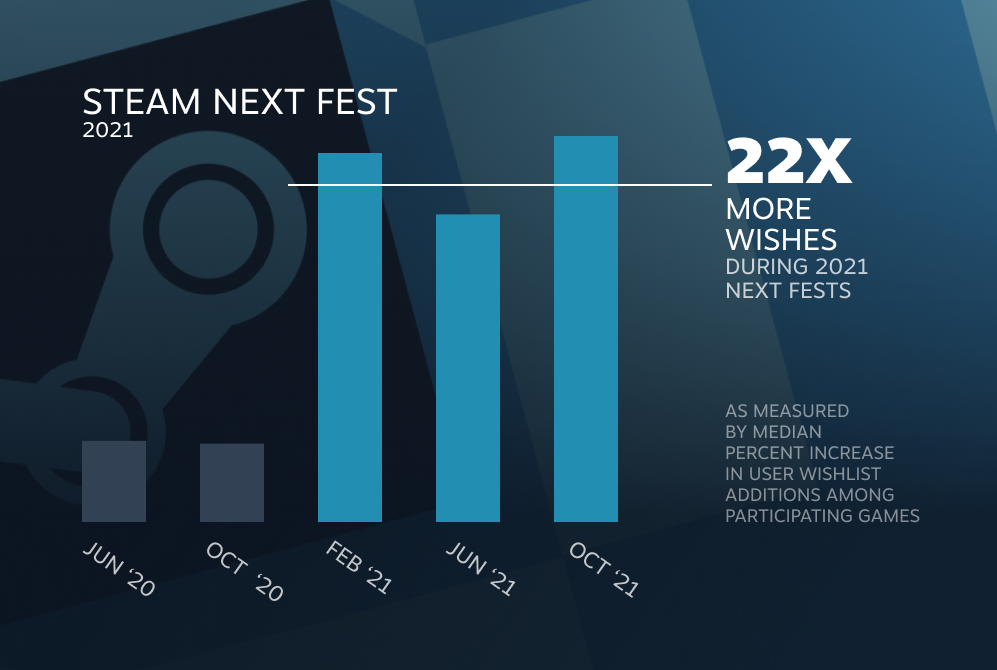




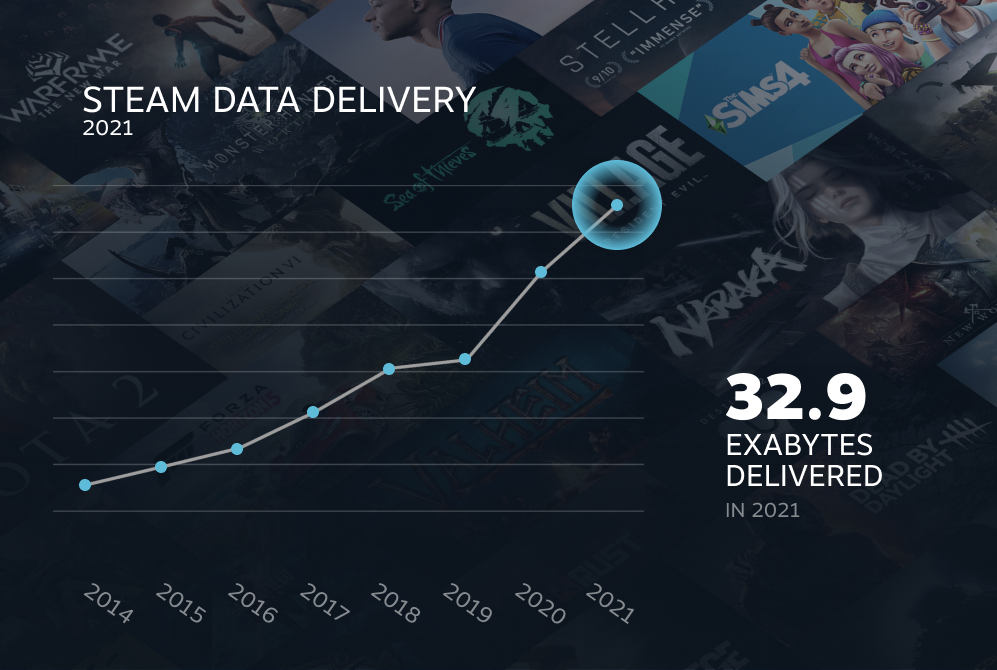




 )
)


